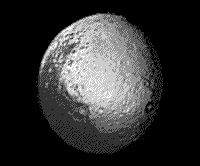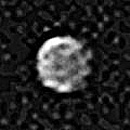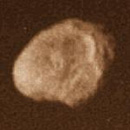

Rhea (1,530 km [951 miles] in diameter) is very similar to Dione, in having a leading hemisphere that has crater densities comparable to the Moon and Mercury, as seen in this close-up, and a trailing hemisphere with few craters, streaks (ejecta rays?), and fractures.
This same theme repeats at Iapetus (1,460 km [907 miles] in diameter), which is further from Saturn. The leading hemisphere has a very low albedo (0.03-0.06 W/m2), in sharp contrast to previously described satellites, and with abrupt boundaries, against the trailing edge terrain (albedo about 0.5), which is heavily cratered. The nature of this dichotomy between satellites is still unknown. This trailing-edge material may have emerged from within Iapetus during crustal foundering. But, the dark terrain is consistent with silicates that have high carbon content, such as those that comprise carbonaceous chondrite meteorites. Thus, this part of Iapetus could have formed as ejecta, which came from another satellite or even from infall of a similar, asteroid-like body.

Between Rhea and Iapetus is the large (5,150 km [3,200 mi]) satellite Titan, which is a "maverick" among the icy group, in that it is quite different in nature.
We enhanced the version shown here to bring out as many details as possible¾ hence we rendered it in reds and yellows —rather than in the natural color that is a light brownish-yellow. Titan appears unlike the others because its dense atmosphere (with surface pressures of 1.5 atm, about 50% higher than Earth's) hides its surface. We show some of this atmospheric structure here:

This atmosphere consists of about 90% molecular nitrogen, 6% argon, with the remainder being methane and organic derivatives, such as hydrogen cyanide, ethane, acetylene, and CO2. Solar radiation breaks some of these constituents into colored compounds, analogous to urban smogs on Earth. Ammonia, now a trace constituent, may once have been more abundant, until dissociating into carbon-nitrogen compounds.
What is below the clouds is uncertain. At Titan’s surface temperatures (- 179° C), the ethane may condense into a liquid "ocean" that is up to a kilometer deep. Below this, Titan probably consists of a layered mix of silicates and water ice. An infrared image, acquired by the Hubble Space Telescope, suggests several rises of material, similar to "continents" (see yellow area in the image above). This mysterious body (larger than Mercury and Pluto)–totally disparate, compared to the other moons¾ may harbor organic molecules of unusual nature, which cry out for study, as the Huygens probe will attempt in the future.
19-66:
Typical of appropriate small satellites is Phoebe (200 km ]134 miles] diameter), orbiting nearly 4x as far out as Iapetus.

Slightly larger (286 km; 179 miles) than Phoebe is the more angular Hyperion:

19-67:

Just as the Galileo spacecraft has added significant knowledge of Jupiter, a sophisticated mission to Saturn is underway. That probe is part of the Cassini mission, named for the 17th Century French-Italian astronomer who pioneered telescopic observations of Saturn. The Cassini spacecraft successfully launched from Cape Canaveral at 4 AM, on October 15, 1997, to begin a 6.7 year journey to the Ringed Planet. The size of a school bus, this vehicle will take a round-about trip to gain velocity by gravity assist "kicks". By passing Venus twice, then Earth again, and Jupiter later, the spacecraft will use their gravitational pulls to increase its speed enough to reach Saturn. JPL manages the mission, with experiments from NASA, the European Space Agency, the Italian Space Agency, and other participants.
The Cassini Orbiter will explore Saturn's magnetosphere, its rings, its icy satellites, and eject the Huygens probe to land on Titan. The Orbiter contains a variety of instruments, including a magnetometer, visible imager, radar, UV and IR spectrometers, ion and mass spectrometers, a plasma spectrometer, a dust analyzer, and radio science instruments.
In November of 2004, the Orbiter will release Huygens to descend through the atmosphere of Titan onto its surface. Named for a Dutch astronomer, who discovered this large satellite, the probe will use a large parachute deployed at 175 km (109 mi) to slow its fall. Then, after jettisoning that one, it will deploy a smaller parachute for the final drop onto the surface, postulated to be liquid, but if solid, then the probe should survive the landing. Huygens will carry a descent imager, spectral radiometer, a Doppler wind measuring device, an aerosol collector, a Gas Chromatograph, a Mass Spectrometer, and a surface science package.
Cassini, which cost in excess of a billion dollars (and raised protests from some environmentalists fearful of its 77 grams of plutonium that will serve as a power source), is the most sophisticated and ambitious probe yet sent to explore the planets.

Primary Author: Nicholas M.
Short, Sr. email: nmshort@epix.net
Contributor Information
Last Updated: September '99
Site Curator: Nannette Fekete